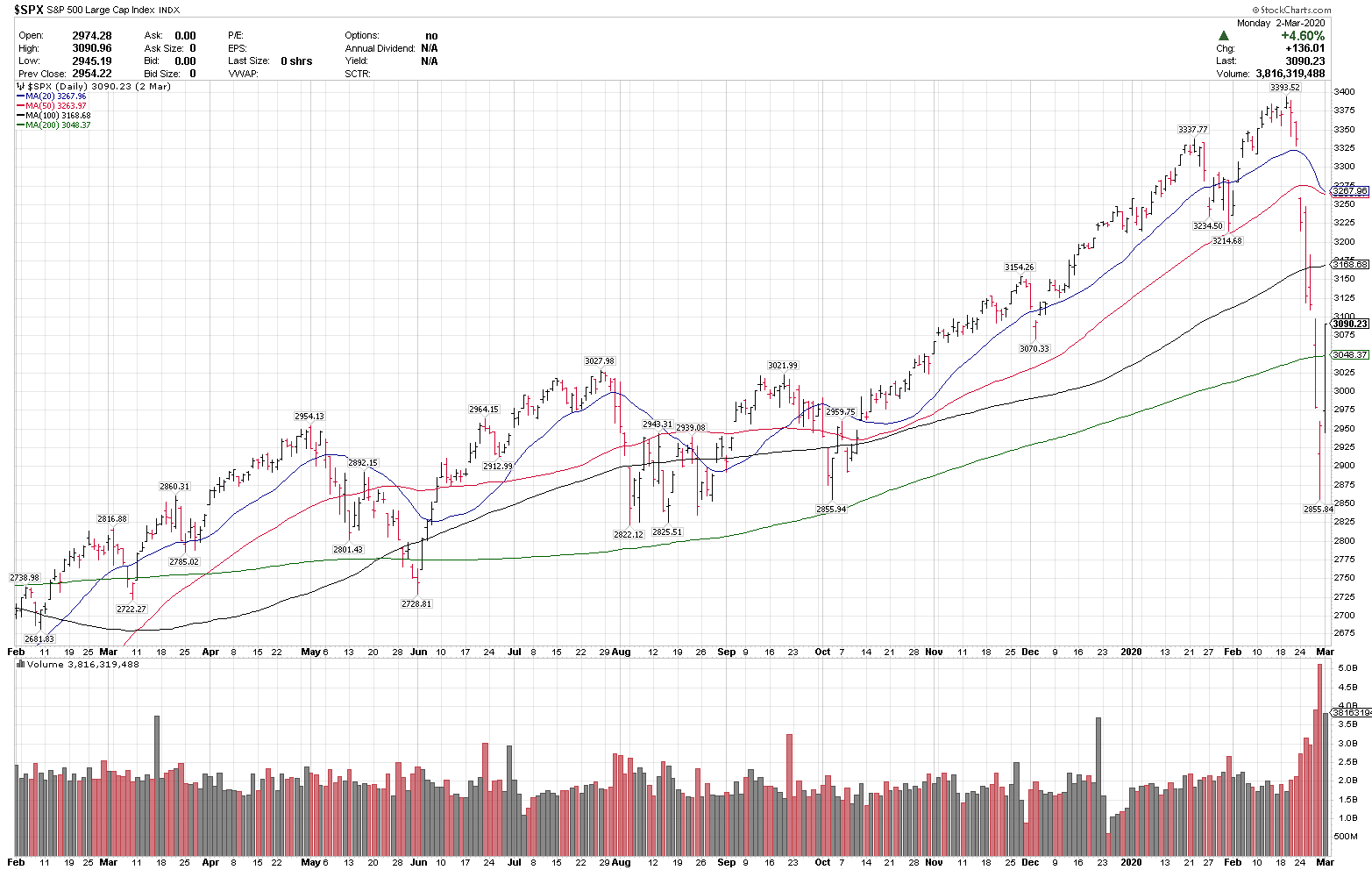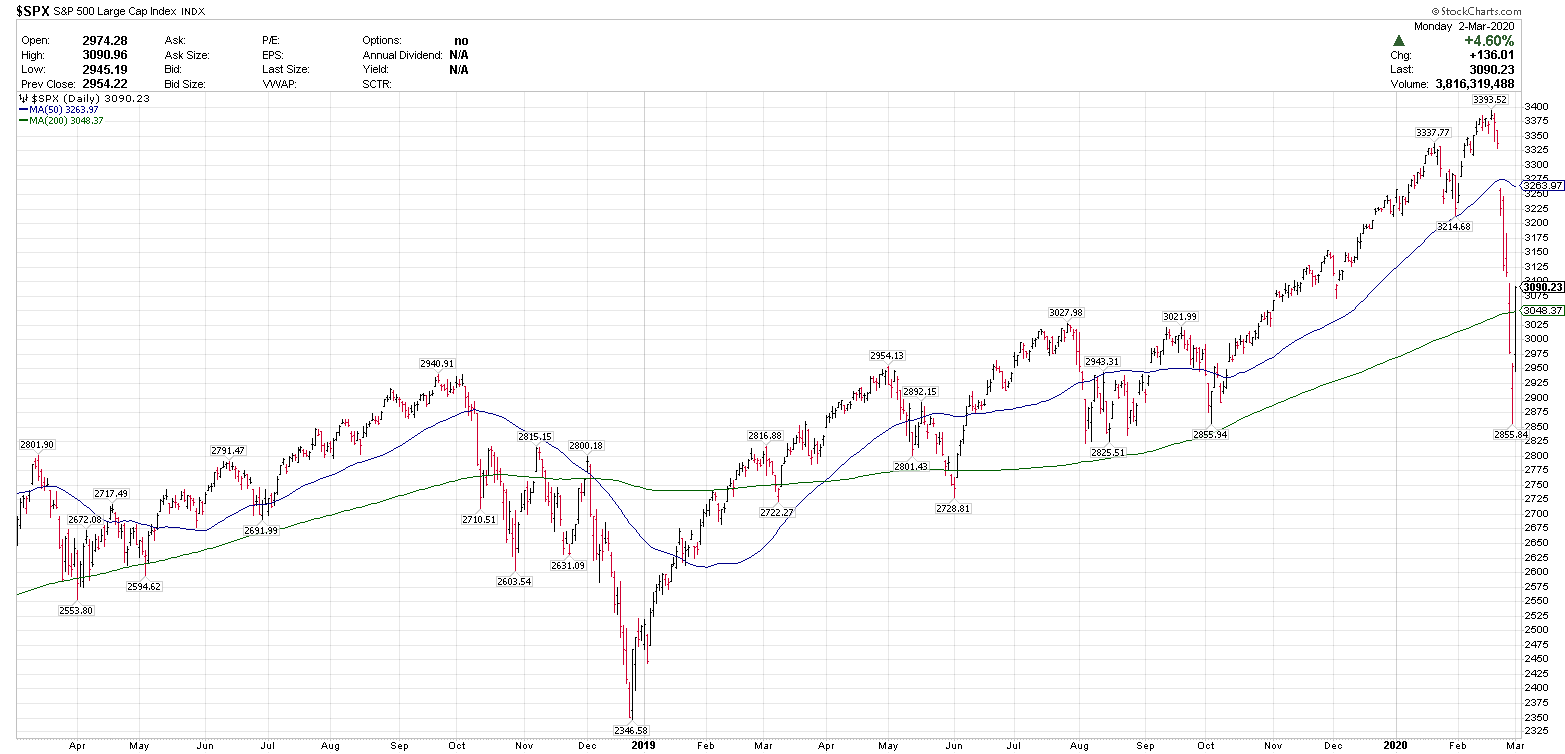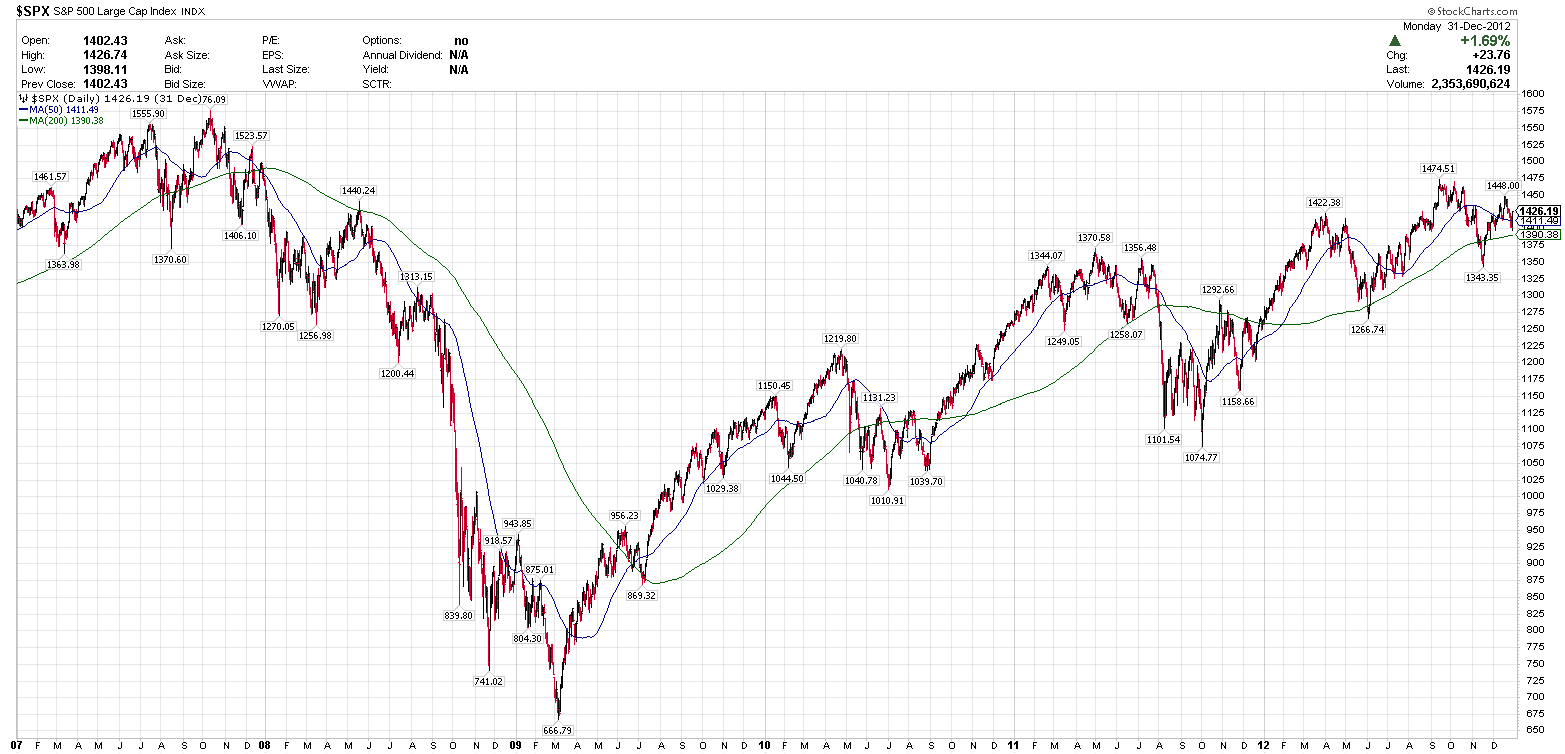This blog was originally published in March 2020. Most of the concepts are not time sensitive.
Volatility has come down recently, but is still at higher than average levels. In this blog and video I am going to discuss the benefits that I see in trading a rules based technical process vs based off opinions, emotions and predictions.
My focus is on trading correctly and managing my positions and my risk correctly, which I can control, and not all of the random items that I can’t control, like popular online topics of the day, healthcare issues (which are very unfortunate and serious), market calls and predictions. I will say that I am very sympathetic to the seriousness and magnitude of the recent healthcare issues, and hope there is a speedy resolution for all.
What I focus on are my positions and my risk.
GENERAL MARKET PULLBACKS
- Always expect market pullbacks and volatility at any time. Markets can pullback for any reason, and SPX is down 48% of the days.
- Always cover the downside first – stops and exits on all open positions.
- Always know where the downside risk levels are and at what levels to focus more on downside controls.
- Don’t risk more than 1% in a position if stopped out.
- In time of higher volatility, higher cash balances help.
- Don’t be in a hurry to buy into every pullback. Corrective phases can be days or weeks or longer.
- Wait until the selling stops first and then assess the charts.
- Avoid trying to buy ‘bargains’ in downtrends or stocks that have rolled over.
- Focus on stocks pulling back over support and in uptrends and then look for a move to the upside first.
- Make test buys – if I have 20% cash to put to work, I might test the markets with one or two 5% positions.
VIDEO BLOG IS HERE: https://zoom.us/rec/share/vNNxN72u0mFOG5Hs8EHlBLIzOtW-X6a81SUX__oPyU3SPirRXlTi8RhX2ZTgvF-G?startTime=1583252636000
The S&P 500, $SPX, just made new all time highs on February 19, at 3393. Less than 7 days later, it traded down to 2855, a 15.8% decline, an extreme decline off record highs.

Volatility is very high these days, emotions are very high, and opinions are rampant. There is an overabundance of opinions floating around about Healthcare issues, and economic consequences, from people who are not trained or experienced healthcare experts or economists. I avoid these discussions entirely. Many are making financial decisions off of these opinions and emotions. Emotions and money are a very bad mix.
Here are a few of my best process oriented ideas to try to keep emotions in check and follow a process in markets:
MAKE TACTICAL ADJUSTMENTS, NOT ‘ALL-IN’ OR ‘ALL-OUT’
Global equity markets had a major selloff last week, with the S & P 500 down over 11% and many global markets and major ETFs down in a similar range. This is often the time when posts will come up online that someone is ‘100% cash’ which sounds great in the downtrends, but is it a viable investing or trading strategy for the majority of us?
While I am an advocate of adjusting cash allocations to help manage risk and manage volatility, and have been at high cash levels recently myself, there is a big difference between having a high cash level as a risk management tool, vs being 100% cash and out of the market entirely. I also know when to start to deploy that cash, with pre-defined risk.
If someone is a day trader, and they close their positions daily, they will usually start every day at 100% cash, so that fits their plan. For those of us who have an intermediate or longer term time frame or who do not want to stare at the screen for 8 hours a day, 100% cash is probably not the best long term plan. $SPY topped at 339, dropped to 285 last week and currently sits at 309. $QQQ topped at 237, made a low at 198 and now sits at $216, 9% higher. If someone goes to all cash, and the lows come and give technical buy signals that they don’t take, at what point do they buy back in?
EMOTIONS AND MONEY ARE A BAD MIX
I do not have any way to predict if last weeks low is the final low in this move or not, or if markets will eventually move much lower, and that is not how I trade. Markets could turn back down and make new lows at any time, or drift into a bear market eventually. I don’t predict the future. I follow a technical process, based on current charts and price, and measure potential reward vs risk.
When volatility picks up in markets, so do emotions. What I have seen happen in most market lows is that many keep looking for more lows, and are so convinced that they don’t buy back in. This was the case in 2009, 2011, 2016 and again in 2018. In the case of $QQQ, the recent low was $198, it traded as low as $205 yesterday and is now at $216. Many will see that $198 was ‘the low’ and not want to buy back in at 205, 208, 210 etc.
DO MARKETS ALWAYS RETEST THE LOWS?
Another commonly held principle is that ‘markets always retest the lows’. Below are the December 2018 and March 2009 major market lows, neither of which came close to being retested. If someone has been waiting for a retest of those lows, how much upside have they missed in markets and individual names?
DEC 2018 LOW, NO RESTEST OF THE 2346.58 LOW

MARCH 2009 LOW, NO RESTEST OF THE 666.79 LOW

PROCESS VS EMOTIONS
1. MEASURE AND MANAGE RISK, WITH A PLAN
When I am at high cash levels, as I have been recently, I always have a potential reentry plan based on the Charts. I always want to think a step ahead, and with if/then scenarios. If markets do A, I do B, if markets do C, I do D. Always planning the next move ahead.
The plan is calculated. When I see a sign of a technical potential low, or buy signal, I will allocate a specified percentage of my cash balance over the next few days in one or two of my best technical ideas on the screen, with correct position sizing and stop losses below. If the positions start to work, I will gradually raise stops along the way to reduce my open risk in the event of a reversal back down. If markets continue to stabilize, I can add exposure and raise stops to keep risk manageable, within my predefined limits. Someone doesn’t have to go all in right away to test the market and can raise exposure accordingly.
2. HAVE A CONSISTENT PLAN TO PUT CAPITAL TO WORK
Measure and manage risk: If I risk 1% in a position, meaning I lose 1% of account equity if I am stopped out, then I may have a plan to ‘risk 2% this week‘. That means I might take one position and risk 2% or two positions and risk 1%. The math is flexible but the concept holds true. Define my risk of exactly how much I am prepared to lose if I am wrong, in my test of the market.
For this example, we will use the recent $QQQ chart. Many technical traders and position traders like myself will often use moving averages and/or key price levels as to manage positions.
In this case on Friday, $QQQ tested it’s rising 200-day moving average, and held on extreme volume, by itself a very bullish technical signal. Price also tested and reclaimed the key $200 price level.
Entry signals: A moving average trader could use the test and hold of the 200-sma or the close that day as an entry signal. The risk would be defined by a stop loss placed not far below the 200-sma, maybe in the $195 – $197 range.
If the trader did not want to hold that position over the weekend due to high volatility and news flow, Monday’s open offered another entry, and traded down into the Friday range as well.
A simple example is a trader could take their position off 1)the successful test of the 200-sma, 2) the close that day over the 200-sma, or 3) Monday’s early morning range, size the stop at a fixed percentage or key level below and define their total position risk at 1%. If they are stopped out, it costs 1%, if the position starts to work, the stop can be raised to reduce risk. Good trading is about finding high potential reward vs defined risk situations.
How high can $QQQ know? Nobody knows. Maybe 216, maybe right back down, maybe new highs. Traders can define the risk by the stop and the market will determine any potential upside.

3. GENERAL MARKET PULLBACKS
Always expect market pullbacks and volatility at any time. Markets can pullback for any reason, and SPX is down 48% of the days.
Always cover the downside first – stops and exits on all open positions.
Always know where the downside risk levels are and at what levels to focus more on downside controls.
Don’t risk more than 1% in a position if stopped out.
In time of higher volatility, higher cash balances help.
Don’t be in a hurry to buy into every pullback. Corrective phases can be days or weeks or longer.
Wait until the selling stops first and then assess the charts.
Avoid trying to buy ‘bargains’ in downtrends or stocks that have rolled over.
Focus on stocks pulling back over support and in uptrends and then look for a move to the upside first.
Make test buys – if I have 20% cash to put to work, I might test the markets with one or two 5% positions.
SUMMARY
Here is what works best for me:
1/ First and always, focus on my positions and my risk.
2/ Focus on trading correctly and managing positions correctly, which I can control, and not all of the random items that I can’t control.
3/ Avoid having opinions on issues that I am not highly knowledgeable about (healthcare, the economy, etc.).
4/ Don’t predict market moves, react to actual price.
5/ Don’t make all-in, all-out calls daily. Tactical adjustments around a core position leads to more consistent returns and less emotional whipsaws.
6/ Focus on charts.
7/ Take the signals.
8/ Cap my risk and predefine the risk.
9/ Manage position sizing, stops, exits and overall account exposure.
10/ Keep the process simple.
